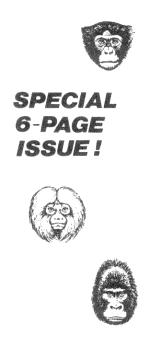 |
 |
 |
|
|
Vol. 90, No. 2
|
Hellmouth, Arizona
|
Mar. 10, 1990
|
| OHHOHOHO FOUND! |
 |
|
The
word that mighty towns and anxious villages all over the world have been
waiting and hoping for was flashed yesterday across television screens,
computer terminals and radio dials everywhere to the accompaniment of a
rising crescendo of congratulations and good wishes. Teletypes and
fax machines overheated and at least one satellite failed in a futile attempt
to satisfy the demand for information as the news spread about Professor
Mitsuo Ohhohoho, who was found alive at last by an international search
team only two miles from where he disappeared last year. The end of
the most celebrated missing persons case since Lindbergh's baby came with
stunning swiftness as the find was announced by Senhor Teófilo Afonso
Rosario Sobradinho. The Brazilian primatologist had been seeking the whereabouts
of his friend and mentor ever since he failed to return to the Urubupunga
Research Station, situated on the wandering banks of the sluggish Carauari
River, deep in the heart of the ancient, ant-strewn Amazon. The professor, author of Mitsuo's Monkeys and My Life with the Macaques, seemed a bit befuddled as he stood blinking in the hot sun, festooned with lianas, his safari jacket torn in two places, and his spectacles slightly askew. He offered no immediate explanation as to where he had been or what he had been doing. The search team, which at one time included fifty-seven people, had shrunk considerably by the time the professor was found. The group had followed what looked like his trail from Urubupunga to Badongo-Gazimbi to the Ipululu Primate Conservation Center, |
|
|
(Cont. on page 2)
|
| EARLY PRIMATE
FOSSILS DISCOVERED IN TOGOBOGO |
|
|||||||||
(Reuters) Ashanti, Togobogo.
Not a few primatologists and several other people were startled last
week to receive sketchy reports on their computer terminals about the discovery
of a large number of important new fossils appearing to be of a primate
affiliation dating from approximately 60 million years ago, the virtual
dawn of the primate age. The fossils were those of an apparently related group of seven individuals from a species whose only other remains were found in 1922 at the southern end of Lake Badongo. From the position of the skeletons, it was evident that a sandstorm or a meteor strike or a landslide or possibly a volcanic eruption or an earthquake or continental drift or a change in the weather or ill will on the part of some other group or just carelessness or something had caused them to be buried suddenly. Researchers speculated that the animals had been peacefully going about their business that luckless afternoon so long ago when disaster struck and they were entombed for millions of months, only to be fortuitously dug up at last by a team of cheerful excavators led by the well-known and much-televised Sir Ian Spotswood Allenby Crofford-Wiggles, called 'Allen' by his friends, one of Ireland's most sought-after primatologists and acknowledged world authority on the giant pygmy chimpanzee. Crofford-Wiggles has been in Togobogo trying to find evidence to support his theory that the primate line began in West Africa. The redoubtable Irishman reacted to the discovery with restrained enthusiasm, first doing an Irish jig and calling out to his ancestors, then jumping up and down and beating the ground with a shillelagh. |